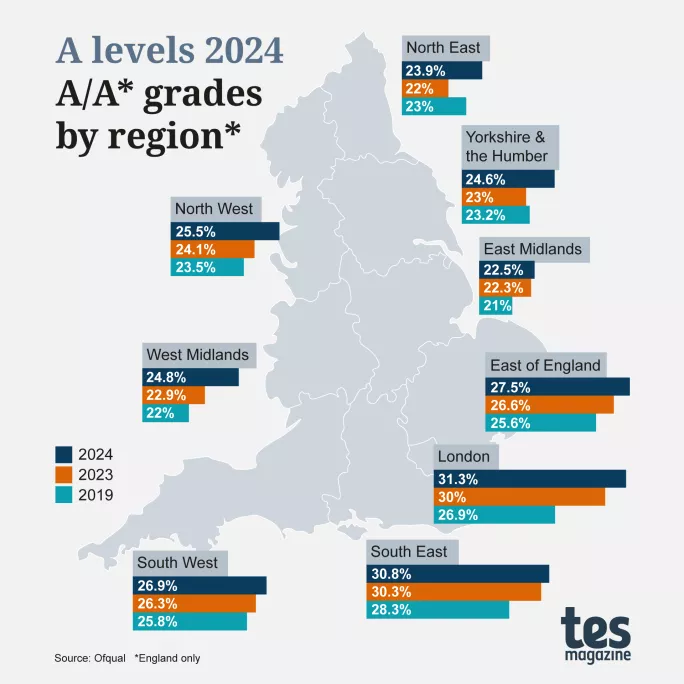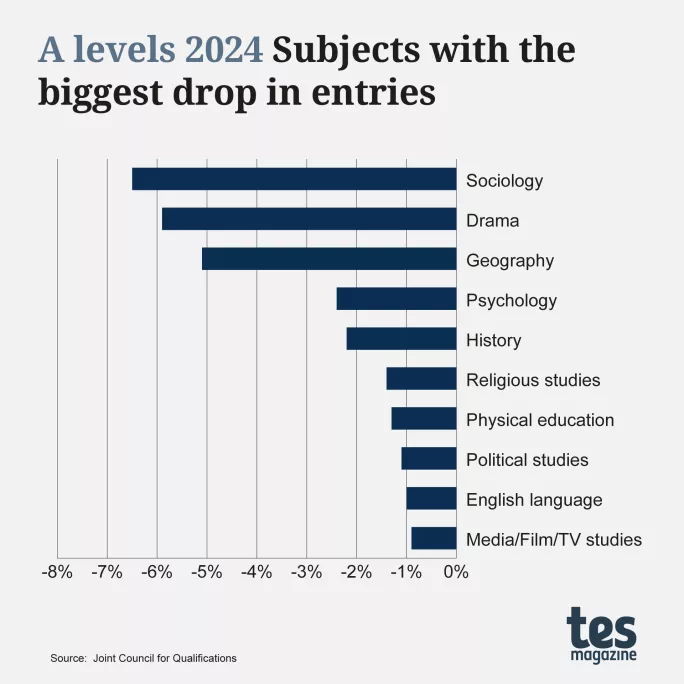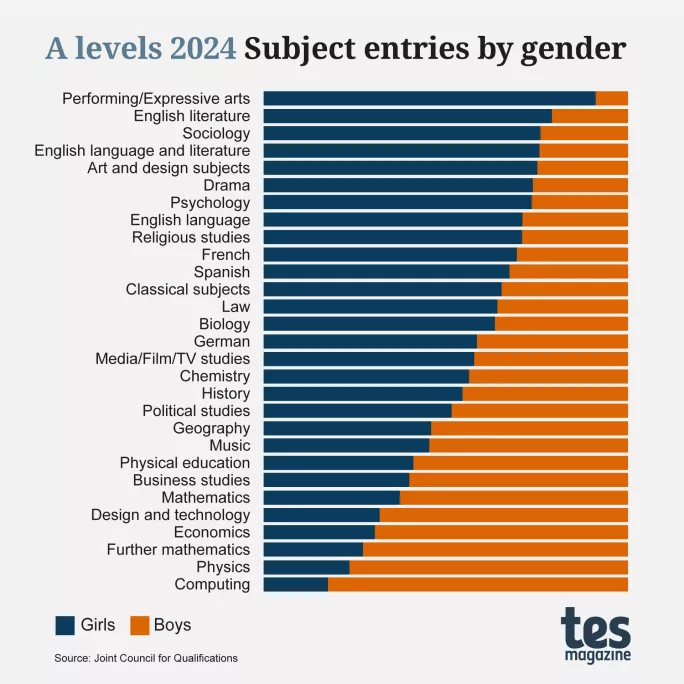8 key trends in this year’s A-level results

A-level results day is here and for students, parents and teachers it means poring over results to see if the hoped-for grades have been achieved - something that will possibly be the case for many, given rises in both A and A* grades compared with last year.
Beyond the headline figures, though, are a raft of other interesting and illuminating trends from the data - including the most popular subjects, those on the wane, the regions that have performed best, and the most common subject combinations.
Tes has been through the array of tables, graphs, charts and infographics published by Ofqual and the Joint Council For Qualifications (JCQ) to bring you the key trends you need to know this A-level results day.
1. Geographical changes
Regional data makes it clear that the rise in top grades has been witnessed in all areas - although, as ever, some have fared better than others.
London and the South East remain the top-performing regions when it comes to A and A* grades, as was the case before and during the pandemic.
Despite London remaining the leading region for top grades, an Education Policy Institute analysis said “there are signs that the rate at which its students are pulling away from those in other regions is starting to slow”.
- More on A-level results day:
- A-level results 2024: Top grades up in England
- Reaction: How resilience in the face of disruption defined this year’s A-level cohort
- Sir Ian Bauckham: Ofqual chief raises concern over region’s A-level performance
- Subjects: How did each area perform?
Meanwhile, all regions in England are now above where they were pre-pandemic - most notably the North East, which rose from 23 per cent in 2019 to 23.9 per cent this year.
While this is not a huge rise between those four years, it does represent a 1.9 percentage point rise on the 22 per cent achieved last year.
Yorkshire and the Humber also saw an improvement that took its outcomes above its 2019 score of 23.2 per cent, rising 1.6 percentage points from 23 per cent to 24.6 per cent.
The map below displays each region’s 2019, 2023 and 2024 data to show these changes.

2. The subject popularity contest
Maths remains the most popular subject at A level, with 107,427 entries across the UK - a significant 12.1 per cent of all A levels. This year marks the first time one subject has surpassed 100,000 entries.
Professor Ulrike Tillmann, chair of the Royal Society’s education committee, said passing this milestone was “exciting to see” and also welcomed the ongoing rises for other Stem subjects (more on this below).
The top five most popular subjects - maths, psychology, biology, chemistry and history - have remained the same as last year.
However, there have been some changes - with business studies overtaking sociology to become the sixth most popular subject with 44,961 entries; sociology is now in seventh place.
Similarly, physics has switched places with economics to become the ninth most popular subject with 43,114 entries, while economics is in tenth position.

3. Subjects on the rise
Stem subjects dominate the list of year-on-year increases in entries across the UK.
Further maths has climbed the most in popularity, with a 19.9 per cent increase in entries from 15,080 in 2023 to 18,082 this year.
Physics is second, with a 12.3 per cent rise in entries. Computing, which came first last year, is now third in year-on-year increases, with 10.9 per cent more students taking the subject in 2024 than in 2023.
Meanwhile, maths cemented its most popular status by increasing entries by 10.9 per cent - making it the fourth biggest riser this year (up considerably on last year, when it was 15th).
This increase is “applaudable”, says Tillmann, adding that it is important to remember “this type of maths education is not for everyone”.
To that end, she says it was “disappointing that core maths entry numbers and results were not announced today”, arguing that the subject should be given more attention to help offer more students a solid grounding in maths skills.

“Until the value of core maths is promoted alongside A level, vocational and technical results, we are unlikely to see more schools and colleges valuing and offering this subject,” she adds.
More surprising is the increase in language A levels, where a corner may have turned - at least that’s what the DfE will be hoping, with each subject up for the first time in some years.
Specifically, while in 2023 entries for French were 10.9 per cent down on the previous year, this year there has been a 6.8 per cent increase, from 7,063 to 7,544. Spanish saw a smaller 1.6 per cent rise to reach 8,238 entries.
Finally, German, a subject that has been in major decline in recent years, saw a 3 per cent increase in entries. While this is good news, it only represents an increase of 73 entries from 2,358 last year to 2,431 this year.
David Blow, fellow of the Association for Language Learning, tells Tes he is “pleased that numbers have increased”, but warns that while these figures are up on 2023, there remains “a substantial drop” in the number of students learning languages since 2019.
Blow puts this down to the decoupling of AS and A levels. “A fourth A level was often French, Spanish or German,” he says. “But now, languages don’t easily fit into the neat Stem or social sciences options students are taking.”
4. Subjects seeing a decline
And with some going up, others must come down.
Despite sociology still being the seventh most popular subject across the UK, this year, its entry numbers have declined the most - with a 6.5 per cent decrease from 47,436 to 44,359.
Elsewhere, drama, religious studies and English language continue to decrease in popularity, following declines last year.
Meanwhile, psychology has had a 2.4 per cent decrease in entries to 78,556 this year - the first time it has shown a decline since 2016. However, it remains the second most popular subject.
Overall, the decline in these popular subjects is notable given the overall rise in A-level entries across the board, from 867,658 in 2023 to 886,514 this year.

5. The gender subject divide
As ever, there are some clear divides by gender between certain subjects. Specifically, Stem subjects remain dominated by boys, while arts and humanities are more often taken by girls.
The most extreme example of this can be seen with performing arts, where just 50 boys took the subject at A level compared with 847 girls. Meanwhile, computing had the biggest divide the other way, with 14,863 boys taking the subject compared with 3,161 girls.
Tillmann laments this divide, telling Tes that “there is still much work to be done to encourage more girls to choose these valuable subjects to prepare them for future opportunities”.
Political studies, music and geography are among the subjects with the most parity in gender take-up.
The table below shows the clear divide across subjects, underlining the difficulty that some departments in schools face to convince boys or girls to take their subjects at A level.
In terms of attainment, girls outperform boys in all grade boundaries, except at A* where boys achieve more - although not by much (9.5 per cent of entries compared with 9.1 for girls).

6. Number of exams being sat
Three remains the magic number when it comes to the number of A levels that most students do, with 188,875 taking this option - equating to 66.8 per cent of the total entries. This was followed by two A levels being taken, which is what 49,300 students did.
Taking a solitary A level is the third most popular option, with 29,495 plumping for this, while a hardy 14,755 took four.
The number taking five A levels was 185 this year - a decline from 210 last year but an exact repeat of the same figure for 2022. No one took six A levels for the second year in a row.
7. Most popular subject combinations
Data from Ofqual reveals the most popular subject combination this year was biology, chemistry and maths, with 18,270 (6.1 per cent) of all students taking this option.
This was almost twice as popular as the second combination - further maths, maths and physics (3.1 per cent) - and more than double as popular as the third most popular combination of chemistry, maths and physics, at 2.8 per cent.
Almost all the top 20 combinations are some variation on the science subjects, with only geography and, perhaps surprisingly, design and technology finding a home within the top 20 combinations.
This data echoes the findings of a report on this issue by the National Foundation For Educational Research earlier this week and report author and senior economist at NFER Michael Scott told Tes it is clear from the subject combinations insights today students are “studying a narrower range of subjects than they did 20 years ago” - something the government should consider addressing.
“It is critical future reforms to the post-16 landscape carefully consider possible impacts on the breadth of subjects that students choose,” he added.
8. AS-level interest falls further
As David Blow referenced earlier in this article, AS levels continue to wane, with data for England showing there were 5.3 per cent fewer entries this year than in 2023 - a fall from 60,530 to 57,294.
This is part of a wider trend: since A levels were reformed, the number of students choosing the qualification has almost halved since 2019, when 114,093 AS levels were sat in England - a decline of over 56,000 entries.
For the latest education news and analysis delivered every weekday morning, sign up to the Tes Daily newsletter
You need a Tes subscription to read this article
Subscribe now to read this article and get other subscriber-only content:
- Unlimited access to all Tes magazine content
- Exclusive subscriber-only stories
- Award-winning email newsletters
Already a subscriber? Log in
You need a subscription to read this article
Subscribe now to read this article and get other subscriber-only content, including:
- Unlimited access to all Tes magazine content
- Exclusive subscriber-only stories
- Award-winning email newsletters
topics in this article



